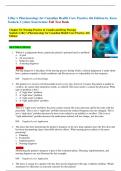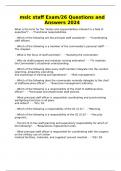Lilley's Pharmacology for Canadian Health Care Practice 4th Edition by Kara Sealock, Cydnee Seneviratne Full Test Bank Chapter 01: Nursing Practice in Canada and Drug Therapy Sealock: Lilley’s Pharmacology for Canadian Health Care Practice, 4th Edition MULTIPLE CHOICE 1. Which is a judgement about a particular patient’s potential need or problem? a. A goal b. An assessment c. Subjective data d. A nursing diagnosis ANS: D Nursing diagnosis is the phase of the nursing process during which a clinical judgement is made about how a patient responds to heath conditions and life processes or vulnerability for that response. DIF: Cognitive Level: Knowledge 2. The patient is to receive oral furosemide (Lasix) every day; however, because the patient is unable to swallow, he cannot take medication orally, as ordered. The nurse needs to contact the physician. What type of problem is this? a. A “right time” problem b. A “right dose” problem c. A “right route” problem d. A “right medication” problem ANS: C This is a “right route” problem: the nurse cannot assume the route and must clarify the route with the prescriber. This is not a “right time” problem because the ordered frequency has not changed. This is not a “right dose” problem because the dose is not related to an inability to swallow. This is not a “right medication” problem because the medication ordered will not change, just the route. DIF: Cognitive Level: Application 3. The nurse has been monitoring the patient’s progress on his new drug regimen since the first dose and has been documenting signs of possible adverse effects. What nursing process phase is the nurse practising? a. Planning b. Evaluation c. Implementation d. Nursing diagnosis ANS: B Monitoring the patient’s progress is part of the evaluation phase. Planning, implementation, and nursing diagnosis are not illustrated by this example. DIF: Cognitive Level: Application 4. The nurse is caring for a patient who has been newly diagnosed with type 1 diabetes mellitus. Which statement best illustrates an outcome criterion for this patient? a. The patient will follow instructions. b. The patient will not experience complications. c. The patient adheres to the new insulin treatment regimen. d. The patient demonstrates safe insulin self-administration technique. ANS: D Having the patient demonstrate safe insulin self -administration technique is a specific and measurable outcome criterion. Following instructions and avoiding complications are not specific criteria. Adherence to the new insulin treatment regimen is not objective and would be difficult to measure. DIF: Cognitive Level: Application 5. Which activity best reflects the implementat ion phase of the nursing process for the patient who is newly diagnosed with type 1 diabetes mellitus? a. Providing education regarding self-injection technique b. Setting goals and outcome criteria with the patient’s input c. Recording a history of over-the-counter medications used at home d. Formulating nursing diagnoses regarding knowledge deficits related to the new treatment regimen ANS: A Education is an intervention that occurs during the implementation phase. Setting goals and outcome criteria reflects the planning phase. Recording a drug history reflects the assessment phase. Formulating nursing diagnoses regarding a knowledge deficit reflects analysis of data as part of the planning phase. DIF: Cognitive Level: Analysis 6. The nurse is working during a very busy night shift, and the health care provider has just given the nurse a medication order over the telephone, but the nurse does not recall the route. What is the best way for the nurse to avoid medication errors? a. Recopy the order neatly on the order sheet, with the most common route indicated b. Consult with the pharmacist for clarification about the most common route c. Call the health care provider to clarify the route of administration d. Withhold the drug until the health care provider visits the patient ANS: C If a medication order does not include the route, the nurse must ask the health care provider to clarify it. Never assume the route of administration. DIF: Cognitive Level: Application | Cognitive Level: Analysis 7. Which constitutes the traditional Five Rights of medication administration? a. Right drug, right route, right dose, right time, and right patient b. Right drug, the right effect, the right route, the right time, and the right patient c. Right patient, right strength, right diagnosis, right drug, and right route d. Right patient, right diagnosis, right drug, right route, and right time ANS: A The traditional Five Rights of medication administration were considered to be Right drug, Right route, Right dose, Right time, and Right patient. Right effect, right strength, and right diagnosis are not part of the traditional Five Rights. DIF: Cognitive Level: Comprehension 8. What correctly describes the nursing process? a. Diagnosing, planning, assessing, implementing, and finally evaluating b. Assessing, then diagnosing, implementing, and ending with evaluating c. A linear direction that begins with assessing and continues through diagnosing, planning, and finally implementing d. An ongoing process that begins with assessing and continues with diagnosing, planning, implementing, and evaluating ANS: D The nursing process is an ongoing, flexible, adaptable, and adjustable five -step process that begins with assessing and continues through diagnosing, planning, implementing, and finally evaluating, which may then lead back to any of the other phases. DIF: Cognitive Level: Application 9. When the nurse is considering the timing of a drug dose, which is most important to assess? a. The patient’s identification b. The patient’s weight c. The patient’s last meal d. Any drug or food allergies ANS: C The pharmacokinetic and pharmacodynamic properties of the drug need to be assessed with regard to any drug –food interactions or compatibility issues. The patient’s identification, weight, and drug or food allergies are not affected by the drug’s timing. DIF: Cognitive Level: Application 10. The nurse is writing nursing diagnoses for a plan of care. Which reflects the correct format for her nursing diagnosis? a. Anxiety b. Anxiety related to new drug therapy c. Anxiety related to anxious feelings about drug therapy, as evidenced by statements such as “I’m upset about having to give myself shots” d. Anxiety related to new drug therapy, as evidenced by statements such as “I’m upset about having to give myself shots” ANS: D Formulation of nursing diagnoses is usually a three -step process. The only complete answer is “Anxiety related to new drug therapy, as evidenced by statements such as ‘I’m upset about having to give myself shots.’” The answer “Anxiety” is missing the “related to” and “as evidenced by” portions. The answer “Anxiety related to new drug therapy” is missing the “as evidenced by” portion of de fining characteristics. The “related to” section in “Anxiety related to anxious feelings about drug therapy, as evidenced by statements such as ‘I’m upset about having to give myself shots’” is simply a restatement of the problem “anxiety,” not a separate factor related to the response. DIF: Cognitive Level: Analysis OTHER 1. Place the phases of the nursing process in the correct order, starting with the first phase. a. Planning b. Evaluation c. Assessment d. Implementation e. Diagnosing ANS: C, E, A, D, B DIF: Cognitive Level: Analysis Chapter 02: Pharmacological Principles Sealock: Lilley’s Pharmacology for Canadian Health Care Practice, 4th Edition MULTIPLE CHOICE 1. A patient is receiving two different drugs, which, at their current dose forms and dosages, are both absorbed into the circulation in identical amounts. Which term best denotes that the drugs have the same absorption rates? a. Equivalent b. Synergistic c. Compatible d. Bioequivalent ANS: D Two drugs absorbed into the circulation at the same amount (in specific dosage forms) have the same bioavailability; thus, they are bioequivalent. “Equivalent” is incorrect because the term “bioavailability” is used to express the extent of drug absorption. “Synergistic” is incorrect because this term refers to two drugs given together whose resulting effect is greater than the sum of the effects of each drug given alone. “Compatible” is incorrect because this term is a general term used to indicate that two substances do not have a chemical reaction when mixed (or given, in the case of drugs) together. DIF: Cognitive Level: Comprehension






